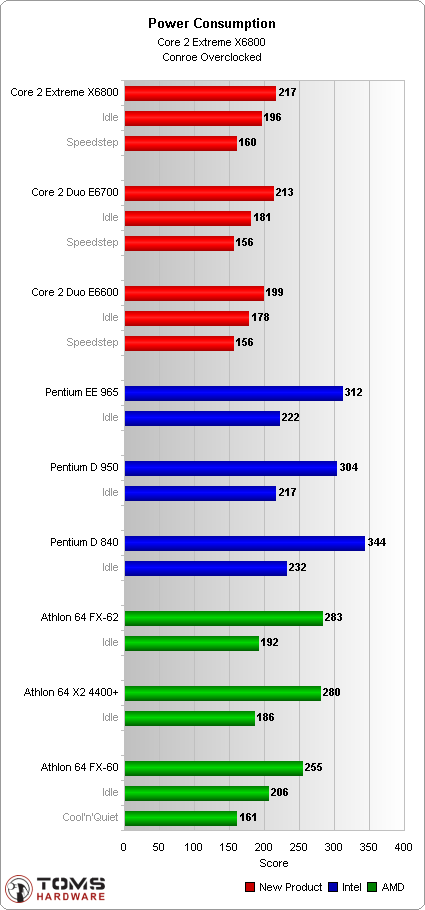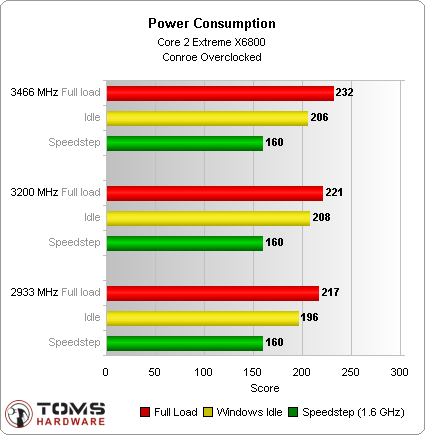Game Over? Core 2 Duo Knocks Out Athlon 64
Power Requirements
In contrast to all 90 and 65 nm Pentium 4 and Pentium D processors the Core 2 Duo processor family requires considerably less energy. All Core 2 Duo processors are rated at 65 W maximum power draw, whereas the Pentium D family is either 95 W or 130 W. Although these are the maximum power consumption figures, our tests show that the average power consumption is also cut into half, and the minimum power draw at low load and with energy-saving mechanisms enabled looks even better.
| Processor | Thermal Design Power |
|---|---|
| Core 2 Extreme X6800 | 75 W |
| Core 2 Duo E6700 | 65 W |
| Core 2 Duo E6600 | 65 W |
| Core 2 Duo E6400 | 65 W |
| Core 2 Duo E6300 | 65 W |
| Pentium D 950 | 115 W |
| Pentium D 840 | 130 W |
| Athlon 64 FX-62 | 125 W |
| Athlon 64 4800+ | 95 W |
| Test System |
|---|
| Intel Core 2 Extreme X6800 |
| Gigabyte ATI Radeon X1900 XTX |
| Asus P5WDH Deluxe |
| 2x Western Digital WD15000ADFD |
| DVD-ROM 16x |
| PC-Power&Cooling Turbo-Cool 510 SSI |
| Terratec 7.1 Sound |
An Intel system running any time of Extreme Edition processor typically draws at least 300 W when it is under full load. This is not the case any more: If you only replace the processor by a fast Core 2 model, you will receive more performance (see benchmarks) at a system power consumption that is in the area of 220 W. This resembles a 30% reduction in energy consumption, which directly relates to decreased cooling requirements.
Our measurements make very clear that the Core 2 micro-architecture makes a huge difference in power consumption. Using Core 2 Extreme X6800 reduces total system power consumption by as much as 30% under maximum load when compared to Pentium Extreme Edition 965, and by 12%/28% when idle (with/without SpeedStep). These numbers are particularly impressive if you take into account that Intel chipsets typically require more energy than chipsets for an Athlon 64 processor and, eventually, the processor has to be very frugal to reduce system power consumption that much.
Even if Core 2 Extreme is overclocked from 2.93 to 3.46 GHz the total system power consumption does not increase a lot. The 18% clock speed increase comes at a system power consumption increase of only 7%.
Get Tom's Hardware's best news and in-depth reviews, straight to your inbox.
Current page: Power Requirements
Prev Page Core 2 Processor Versions Next Page Die Size And Transistor Count
Patrick Schmid was the editor-in-chief for Tom's Hardware from 2005 to 2006. He wrote numerous articles on a wide range of hardware topics, including storage, CPUs, and system builds.

